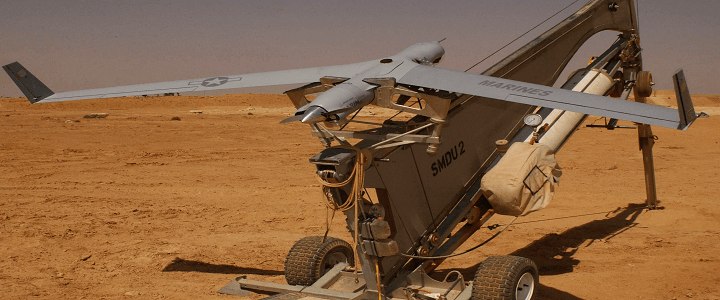In recent years many industries have made serious investment in robotics and artificial intelligence (AI). Robotics continues to be used on production lines, while AI is used in IoT (Internet of Things)-based consumer products, self-driving vehicles, and even in cybersecurity platforms.
After years of sequestration and flat-lined Department of Defense budgets, the military is now catching up. According to recent reports, the U.S. Army has plans to spend $115 million on robotics development, while the U.S. Navy could be spending upwards of $450 million on unmanned surface vehicles.
As outlined in the 2020 budget proposal, the DoD has made it clear robotics and autonomous systems are the future of warfare. According to a report by AUVSI, the DoD plans to invest roughly $5.5 billion into the development, testing and deployment of unmanned technology in FY 2020.
AI and Robotics at Sea
The U.S. Navy and Marines have been working on ways to better integrate AI into weapons systems, and the Navy’s fiscal 2020 budget includes a request that targets the development of AI platforms. The Navy requested a 9.5% budget increase from the 2019 budget that would cover the AI and unmanned systems R&D.
“As we move from rebuilding readiness to owning the next fight, this budget prioritizes a balanced and strategy-driven approach to provide for a bigger, better trained and more ready force,” said Secretary of the Navy Richard Spencer in testimony before the House Armed Services Committee in April.
AI is being used by the Navy for mine countermeasure missions, while unmanned underwater vehicles are being equipped with AI that could collect sonar data which could be used to recognize and identify mines from other debris in the water, and then examine those mines. AI is also being used in anti-submarine warfare missions, where sensors could collect data and use machine learning to separate distant enemy submarines from noise.
AI and robotics are two platforms that fit very well with the mission of the U.S. Navy.
“Navies around the world are finally embracing unmanned technologies, particularly in the field of mine countermeasures and anti-submarine warfare,” explained Scott Clark, global program director for defence at the UK offices of Frost & Sullivan.
“The U.S. Navy has had a long term investment in unmanned underwater systems that has failed due to technology limitations, in areas such as communications and power generation and storage,” Clark told ClearanceJobs. “These technologies are now available, and hence UUVs are now starting to enter into maritime capability plans.”
Army Marches Forward With AI
The U.S. Army is also investing in AI, which is being combined with robotic and other unmanned platforms to enable so-called “smart” weapons systems. These systems are being developed to use AI to augment human operators for multiple purposes including targeting and navigation.
In March the Army announced that it was investing $72 million in a five-year AI fundamental research effort to research and discover capabilities that would significantly enhance mission effectiveness by augmenting soldiers, optimizing operations, increasing readiness and reducing casualties. The Combat Capabilities Development Command Army Research Laboratory, the U.S. Army’s corporate laboratory (ARL), also announced that Carnegie Mellon University will lead a consortium of multiple universities to work in collaboration with the Army lab to accelerate research and development of advanced algorithms, autonomy and artificial intelligence to enhance national security and defense.
High Tech Arms Race
The DoD’s investment in AI and robotics could be seen is a crucial step in not lagging behind other powers on the world stage.
“The U.S. military sought a significant boost to funding increases for autonomous weapons and unmanned systems development that exceeds $3billion, according to the fiscal year 2020 budget request submitted to Congress in March 2019,” noted Kelvin Wong, principal naval journalist at Jane’s by IHS Markit.
“The request reflects a determined effort to address increasingly sophisticated and lethal technologies and weapons being brought to active service by China and Russia,” Wong told ClearanceJobs. “For example, among China’s wide-ranging modernization effort is a clear interest in AI and unmanned systems, with one notable development being large unmanned surface vessels (USVs) that could potentially undertake surface warfare missions in support of its naval fleet.”
The USN stands out among other U.S. military services for its strong emphasis on developing autonomous unmanned systems for surface, underwater, and aerial operations , including a fleet of Large Unmanned Surface Vessels (LUSVs), which are envisioned to be corvette-sized and capable of mounting diverse ranges of missions from anti-submarine to surface warfare and strike, added Wong.
“The service is also pursuing more capable unmanned underwater systems such as the Extra Large Unmanned Underwater Vehicle (XLUUV) which are expected to offer much greater endurance and payload carrying capacity over existing systems,” explained Wong. “The Navy’s air operations will likewise stand to gain from the future MQ-25 Stingray unmanned aerial vehicle (UAV) that will perform aerial refueling and surveillance missions to augment its manned aircraft.”
These recent developments all demonstrate a trend towards building larger and more complex unmanned platforms that move beyond the ‘dull, dirty, and dangerous’ roles that these systems have been traditionally used for – such as mine countermeasures and coastal surveillance – a clear indication that the technologies that govern these systems are now considered mature enough for widespread use.
“Moreover, another trajectory is the increasing size of these unmanned platforms, which can rival manned platforms in some cases,” said Wong. “Unmanned platforms remain largely relegated to ancillary roles such as intelligence gathering, surveillance, and patrol/presence today across the world today, so I certainly won’t consider the U.S. Navy to be a laggard in terms of unmanned systems development, considering the U.S. DoD’s clearly articulated interest, the scale and scope of R&D efforts currently underway, and the advanced industrial and R&D base that is supporting these programs.”



